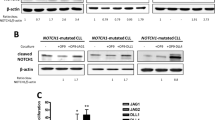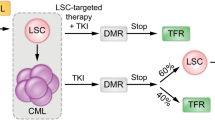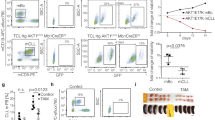Abstract
The p53 tumor suppressor protein has a key role in the induction of apoptosis of chronic lymphocytic leukemia (CLL) cells. Abnormalities within the p53 pathway identify a subset of patients with a poor prognosis. This review describes recent advances in understanding the mechanisms that regulate p53 levels and the role of p53 in the control of the cell cycle and of apoptosis. The classical model of p53-mediated apoptosis emphasizes the transcriptional activation of proapoptotic genes. In contrast, a novel model emphasizes p53's non-transcriptional actions as the major route of apoptosis induction, whereas its transcriptional arm predominantly upregulates antiapoptotic genes, thus providing a negative feedback mechanism that limits apoptosis. Further studies have identified the Notch pathway as a candidate p53-induced antiapoptotic mechanism. In contrast to the classical model, the novel model predicts that pharmacological inhibition of p53's transcriptional function or of the Notch signaling pathway will augment apoptosis induction by cytotoxic agents. Therapeutic strategies based on the novel model, which we review here for the first time, may significantly augment the antitumor actions of cytotoxic agents in CLL and in other malignancies.
This is a preview of subscription content, access via your institution
Access options
Subscribe to this journal
Receive 12 print issues and online access
$259.00 per year
only $21.58 per issue
Buy this article
- Purchase on Springer Link
- Instant access to full article PDF
Prices may be subject to local taxes which are calculated during checkout



Similar content being viewed by others
References
Vousden KH, Lane DP . p53 in health and disease. Nat Rev Mol Cell Biol 2007; 8: 275–283.
Kruse JP, Gu W . Modes of p53 regulation. Cell 2009; 137: 609–622.
Pietsch EC, Sykes SM, McMahon SB, Murphy ME . The p53 family and programmed cell death. Oncogene 2008; 27: 6507–6521.
Vousden KH, Prives C . P53 and prognosis: new insights and further complexity. Cell 2005; 120: 7–10.
Vousden KH . Outcomes of p53 activation--spoilt for choice. J Cell Sci 2006; 119: 5015–5020.
Chipuk JE, Green DR . Cytoplasmic p53: bax and forward. Cell Cycle 2004; 3: 429–431.
Moll UM, Wolff S, Speidel D, Deppert W . Transcription-independent pro-apoptotic functions of p53. Curr Opin Cell Biol 2005; 17: 631–636.
Zhang Y, Xiong Y . Control of p53 ubiquitination and nuclear export by MDM2 and ARF. Cell Growth Differ 2001; 12: 175–186.
Mayo LD, Donner DB . A phosphatidylinositol 3-kinase pathway promotes translocation of Mdm2 from the cytoplasm to the nucleus. Proc Natl Acad Sci USA 2001; 98: 11598–11603.
Ogawara Y, Kishishita S, Obata T, Isazawa Y, Suzuki T, Tanaka K et al. Akt enhances Mdm2-mediated ubiquitination and degradation of p53. J Biol Chem 2002; 277: 21843–21850.
Youle RJ, Strasser A . The BCL-2 protein family: opposing activities that mediate cell death. Nat Rev Mol Cell Biol 2008; 9: 47–59.
Lassus P, Ferlin M, Piette J, Hibner U . Anti-apoptotic activity of low levels of wild-type p53. EMBO J 1996; 15: 4566–4573.
Bensaad K, Tsuruta A, Selak MA, Vidal MN, Nakano K, Bartrons R et al. TIGAR, a p53-inducible regulator of glycolysis and apoptosis. Cell 2006; 126: 107–120.
Budanov AV, Sablina AA, Feinstein E, Koonin EV, Chumakov PM . Regeneration of peroxiredoxins by p53-regulated sestrins, homologs of bacterial AhpD. Science 2004; 304: 596–600.
Janicke RU, Sohn D, Schulze-Osthoff K . The dark side of a tumor suppressor: anti-apoptotic p53. Cell Death Differ 2008; 15: 959–976.
Haupt Y, Rowan S, Shaulian E, Vousden KH, Oren M . Induction of apoptosis in HeLa cells by trans-activation-deficient p53. Genes Dev 1995; 9: 2170–2183.
Chipuk JE, Maurer U, Green DR, Schuler M . Pharmacologic activation of p53 elicits Bax-dependent apoptosis in the absence of transcription. Cancer Cell 2003; 4: 371–381.
Leu JI, Dumont P, Hafey M, Murphy ME, George DL . Mitochondrial p53 activates Bak and causes disruption of a Bak-Mcl1 complex. Nat Cell Biol 2004; 6: 443–450.
Tait SW, Green DR . Mitochondria and cell death: outer membrane permeabilization and beyond. Nat Rev Mol Cell Biol 2010; 11: 621–632.
Chipuk JE, Bouchier-Hayes L, Kuwana T, Newmeyer DD, Green DR . PUMA couples the nuclear and cytoplasmic proapoptotic function of p53. Science 2005; 309: 1732–1735.
Talos F, Petrenko O, Mena P, Moll UM . Mitochondrially targeted p53 has tumor suppressor activities in vivo. Cancer Res 2005; 65: 9971–9981.
Mihara M, Erster S, Zaika A, Petrenko O, Chittenden T, Pancoska P et al. p53 has a direct apoptogenic role at the mitochondria. Mol Cell 2003; 11: 577–590.
Petros AM, Gunasekera A, Xu N, Olejniczak ET, Fesik SW . Defining the p53 DNA-binding domain/Bcl-x(L)-binding interface using NMR. FEBS Lett 2004; 559: 171–174.
Chipuk JE, Green DR . Dissecting p53-dependent apoptosis. Cell Death Differ 2006; 13: 994–1002.
Alimirah F, Panchanathan R, Davis FJ, Chen J, Choubey D . Restoration of p53 expression in human cancer cell lines upregulates the expression of Notch1: implications for cancer cell fate determination after genotoxic stress. Neoplasia 2007; 9: 427–434.
Steele AJ, Prentice AG, Hoffbrand AV, Yogashangary BC, Hart SM, Nacheva EP et al. p53-mediated apoptosis of CLL cells: evidence for a transcription-independent mechanism. Blood 2008; 112: 3827–3834.
Secchiero P, Melloni E, di Iasio MG, Tiribelli M, Rimondi E, Corallini F et al. Nutlin-3 up-regulates the expression of Notch1 in both myeloid and lymphoid leukemic cells, as part of a negative feedback antiapoptotic mechanism. Blood 2009; 113: 4300–4308.
Fortini ME . Notch signaling: the core pathway and its posttranslational regulation. Dev Cell 2009; 16: 633–647.
Screpanti I, Bellavia D, Campese AF, Frati L, Gulino A . Notch, a unifying target in T-cell acute lymphoblastic leukemia? Trends Mol Med 2003; 9: 30–35.
Baud V, Karin M . Is NF-κB a good target for cancer therapy? Hopes and pitfalls. Nat Rev Drug Discov 2009; 8: 33–40.
Palomero T, Lim WK, Odom DT, Sulis ML, Real PJ, Margolin A et al. NOTCH1 directly regulates c-MYC and activates a feed-forward-loop transcriptional network promoting leukemic cell growth. Proc Natl Acad Sci USA 2006; 103: 18261–18266.
Palomero T, Dominguez M, Ferrando AA . The role of the PTEN/AKT Pathway in NOTCH1-induced leukemia. Cell Cycle 2008; 7: 965–970.
Lawlor MA, Alessi DR . PKB/Akt: a key mediator of cell proliferation, survival and insulin responses? J Cell Sci 2001; 114: 2903–2910.
Wattel E, Preudhomme C, Hecquet B, Vanrumbeke M, Quesnel B, Dervite I et al. p53 mutations are associated with resistance to chemotherapy and short survival in hematologic malignancies. Blood 1994; 84: 3148–3157.
Dohner H, Fischer K, Bentz M, Hansen K, Benner A, Cabot G et al. p53 gene deletion predicts for poor survival and non-response to therapy with purine analogs in chronic B-cell leukemias. Blood 1995; 85: 1580–1589.
Bullrich F, Rasio D, Kitada S, Starostik P, Kipps T, Keating M et al. ATM mutations in B-cell chronic lymphocytic leukemia. Cancer Res 1999; 59: 24–27.
Starostik P, Manshouri T, O’Brien S, Freireich E, Kantarjian H, Haidar M et al. Deficiency of the ATM protein expression defines an aggressive subgroup of B-cell chronic lymphocytic leukemia. Cancer Res 1998; 58: 4552–4557.
Stankovic T, Weber P, Stewart G, Bedenham T, Murray J, Byrd PJ et al. Inactivation of ataxia telangiectasia mutated gene in B-cell chronic lymphocytic leukaemia. Lancet 1999; 353: 26–29.
Kay NE, O’Brien SM, Pettitt AR, Stilgenbauer S . The role of prognostic factors in assessing ‘high-risk’ subgroups of patients with chronic lymphocytic leukemia. Leukemia 2007; 21: 1885–1891.
Zenz T, Benner A, Dohner H, Stilgenbauer S . Chronic lymphocytic leukemia and treatment resistance in cancer: the role of the p53 pathway. Cell Cycle 2008; 7: 3810–3814.
Zenz T, Krober A, Scherer K, Habe S, Buhler A, Benner A et al. Monoallelic TP53 inactivation is associated with poor prognosis in chronic lymphocytic leukemia: results from a detailed genetic characterization with long-term follow-up. Blood 2008; 112: 3322–3329.
Austen B, Skowronska A, Baker C, Powell JE, Gardiner A, Oscier D et al. Mutation status of the residual ATM allele is an important determinant of the cellular response to chemotherapy and survival in patients with chronic lymphocytic leukemia containing an 11q deletion. J Clin Oncol 2007; 25: 5448–5457.
Stankovic T, Hubank M, Cronin D, Stewart GS, Fletcher D, Bignell CR et al. Microarray analysis reveals that TP53- and ATM-mutant B-CLLs share a defect in activating proapoptotic responses after DNA damage but are distinguished by major differences in activating prosurvival responses. Blood 2004; 103: 291–300.
Best OG, Gardiner AC, Davis ZA, Tracy I, Ibbotson RE, Majid A et al. A subset of Binet stage A CLL patients with TP53 abnormalities and mutated IGHV genes have stable disease. Leukemia 2009; 23: 212–214.
Tam CS, Shanafelt TD, Wierda WG, Abruzzo LV, Van Dyke DL, O’Brien S et al. De novo deletion 17p13.1 chronic lymphocytic leukemia shows significant clinical heterogeneity: the M.D. Anderson and Mayo Clinic experience. Blood 2009; 114: 957–964.
Zenz T, Eichorst B, Busch R, Denzel T, Häbe S, Winkler D et al. TP53 mutation and survival in chronic lymphocytic leukemia. J Clin Oncol 2010; 28: 4473–4479.
Demarest RM, Ratti F, Capobianco AJ . It's T-ALL about Notch. Oncogene 2008; 27: 5082–5091.
Chen J, Jette C, Kanki JP, Aster JC, Look AT, Griffin JD . NOTCH1-induced T-cell leukemia in transgenic zebrafish. Leukemia 2007; 2: 462–471.
Kox C, Zimmermann M, Stanulla M, Leible S, Schrappe M, Ludwig WD et al. The favorable effect of activating NOTCH1 receptor mutations on long-term outcome in T-ALL patients treated on the ALL-BFM 2000 protocol can be separated from FBXW7 loss of function. Leukemia 2010; 24: 2005–2013.
Clappier E, Collette S, Grardel N, Girard S, Suarez L, Brunie G et al. NOTCH1 and FBXW7 mutations have a favorable impact on early response to treatment, but not on outcome, in children with T-cell acute lymphoblastic leukemia (T-ALL) treated on EORTC trials 58881 and 58951. Leukemia 2010; 24: 2023–2031.
Zuurbier L, Homminga I, Calvert V, te Winkel ML, Buijs-Gladdines JG, Kooi C et al. NOTCH1 and/or FBXW7 mutations predict for initial good prednisone response but not for improved outcome in pediatric T-cell acute lymphoblastic leukemia patients treated on DCOG or COALL protocols. Leukemia 2010; 24: 2014–2022.
Real PJ, Ferrando AA . NOTCH inhibition and glucocorticoid therapy in T-cell acute lymphoblastic leukemia. Leukemia 2009; 23: 1374–1377.
Hubmann R, Schwarzmeier JD, Shehata M, Hilgarth M, Duechler M, Dettke M et al. Notch2 is involved in the overexpression of CD23 in B-cell chronic lymphocytic leukemia. Blood 2002; 99: 3742–3747.
Duechler M, Shehata M, Schwarzmeier JD, Hoelbl A, Hilgarth M, Hubmann R . Induction of apoptosis by proteasome inhibitors in B-CLL cells is associated with downregulation of CD23 and inactivation of Notch2. Leukemia 2005; 19: 260–267.
Rosati E, Sabatini R, Rampino G, Tabilio A, Di IM, Fettucciari K et al. Constitutively activated Notch signaling is involved in survival and apoptosis resistance of B-CLL cells. Blood 2009; 113: 856–865.
Vassilev LT, Vu BT, Graves B, Carvajal D, Podlaski F, Filipovic Z et al. In vivo activation of the p53 pathway by small-molecule antagonists of MDM2. Science 2004; 303: 844–848.
Coll-Mulet L, Iglesias-Serret D, Santidrian AF, Cosialls AM, de FM, Castano E et al. MDM2 antagonists activate p53 and synergize with genotoxic drugs in B-cell chronic lymphocytic leukemia cells. Blood 2006; 107: 4109–4114.
Kojima K, Konopleva M, McQueen T, O’Brien S, Plunkett W, Andreeff M . Mdm2 inhibitor Nutlin-3a induces p53-mediated apoptosis by transcription-dependent and transcription-independent mechanisms and may overcome Atm-mediated resistance to fludarabine in chronic lymphocytic leukemia. Blood 2006; 108: 993–1000.
Secchiero P, Barbarotto E, Tiribelli M, Zerbinati C, di Iasio MG, Gonelli A et al. Functional integrity of the p53-mediated apoptotic pathway induced by the nongenotoxic agent nutlin-3 in B-cell chronic lymphocytic leukemia (B-CLL). Blood 2006; 107: 4122–4129.
Best OG, Gardiner AC, Majid A, Walewska R, Austen B, Skowronska A et al. A novel functional assay using etoposide plus nutlin-3a detects and distinguishes between ATM and TP53 mutations in CLL. Leukemia 2008; 22: 1456–1459.
Bixby D, Kujawski L, Wang S, Malek SN . The pre-clinical development of MDM2 inhibitors in chronic lymphocytic leukemia uncovers a central role for p53 status in sensitivity to MDM2 inhibitor-mediated apoptosis. Cell Cycle 2008; 7: 971–979.
Ventura A, Kirsch DG, McLaughlin ME, Tuveson DA, Grimm J, Lintault L et al. Restoration of p53 function leads to tumour regression in vivo. Nature 2007; 445: 661–665.
Selivanova G . Therapeutic targeting of p53 by small molecules. Semin Cancer Biol 2010; 20: 46–56.
Nahi H, Lehmann S, Mollgard L, Bengtzen S, Selivanova G, Wiman KG et al. Effects of PRIMA-1 on chronic lymphocytic leukaemia cells with and without hemizygous p53 deletion. Br J Haematol 2004; 127: 285–291.
Steele AJ, Jones DT, Ganeshaguru K, Duke VM, Yogashangary BC, North JM et al. The sesquiterpene lactone parthenolide induces selective apoptosis of B-chronic lymphocytic leukemia cells in vitro. Leukemia 2006; 20: 1073–1079.
Alvi AJ, Austen B, Weston VJ, Fegan C, MacCallum D, Gianella-Borradori A et al. A novel CDK inhibitor, CYC202 (R-roscovitine), overcomes the defect in p53-dependent apoptosis in B-CLL by down-regulation of genes involved in transcription regulation and survival. Blood 2005; 105: 4484–4491.
Lin TS, Ruppert AS, Johnson AJ, Fischer B, Heerema NA, Andritsos LA et al. Phase II study of flavopiridol in relapsed chronic lymphocytic leukemia demonstrating high response rates in genetically high-risk disease. J Clin Oncol 2009; 27: 6012–6018.
Steele AJ, Prentice AG, Hoffbrand AV, Yogashangary BC, Hart SM, Lowdell MW et al. 2-Phenylacetylenesulfonamide (PAS) induces p53-independent apoptotic killing of B-chronic lymphocytic leukemia (CLL) cells. Blood 2009; 114: 1217–1225.
Lin K, Rockliffe N, Johnson GG, Sherrington PD, Pettitt AR . Hsp90 inhibition has opposing effects on wild-type and mutant p53 and induces p21 expression and cytotoxicity irrespective of p53/ATM status in chronic lymphocytic leukaemia cells. Oncogene 2008; 27: 2445–2455.
Del Gaizo Moore V, Brown JR, Certo M, Love TM, Novina CD, Letai A . Chronic lymphocytic leukemia requires BCL2 to sequester prodeath BIM, explaining sensitivity to BCL2 antagonist ABT-737. J Clin Invest 2007; 117: 112–121.
Vogler M, Dinsdale D, Sun XM, Young KW, Butterworth M, Nicotera P et al. A novel paradigm for rapid ABT-737-induced apoptosis involving outer mitochondrial membrane rupture in primary leukemia and lymphoma cells. Cell Death Differ 2008; 15: 820–830.
Mason KD, Khaw SL, Rayeroux KC, Chew E, Lee EF, Fairlie WD et al. The BH3 mimetic compound, ABT-737, synergizes with a range of cytotoxic chemotherapyagents in chronic lymphocytic leukemia. Leukemia 2009; 23: 2034–2041.
Paoluzzi L, Gonen M, Bhagat G, Furman RR, Gardner JR, Scotto L et al. The BH3-only mimetic ABT-737 synergizes the antineoplastic activity of proteasome inhibitors in lymphoid malignancies. Blood 2008; 112: 2906–2916.
Hillmen P, Skotnicki AB, Robak T, Jaksic B, Dmoszynska A, Wu J et al. Alemtuzumab compared with chlorambucil as first-line therapy for chronic lymphocytic leukemia. J Clin Oncol 2007; 25: 5616–5623.
Stilgenbauer S, Zenz T, winkler D, Buhler A, Schlenk RF, Groner S et al. Subcutaneous alemtuzumab in fludarabine-refractory chronic lymphocytic leukemia: clinical results and prognostic marker analyses from the CLL2H study of the German Chronic Lymphocytic Leukemia Study Group. J Clin Oncol 2009; 27: 3994–4001.
Byrd JC, Lin TS, Dalton JT, Wu D, Phelps MA, Fischer B et al. Flavopiridol administered using a pharmacologically derived schedule is associated with marked clinical efficacy in refractory genetically high-risk chronic lymphocytic leukemia. Blood 2007; 109: 399–404.
Lapalombella R, Andritsos L, Liu Q, May SE, Browning R, Pham LV et al. Lenalidomide treatments promotes CD154 expression on CLL cells and enhances production of antibodies by normal B cells through a PI3-kinase-dependent pathway. Blood 2010; 115: 2619–2629.
Ferrajoli A, Lee BN, Schette EJ, O’Brien SM, Gao H, Wen S et al. Lenalidomide induces complete and partial remissions in patients with relapsed and refractory chronic lymphocytic leukemia. Blood 2008; 111: 5291–5297.
Sher T, Miller KC, Lawrence D, Whitworth A, Hernandez-Ilizaliturri F, Czuczman MS et al. Efficacy of lenalidomide in patients with chronic lymphocytic leukemia with high-risk cytogenetics. Leuk Lymphoma 2010; 51: 85–88.
Vaseva AV, Marchenko ND, Moll UM . The transcription-independent mitochondrial p53 program is a major contributor to nutlin-induced apoptosis in tumor cells. Cell Cycle 2009; 8: 1711–1719.
Dinca EB, Lu KV, Sarkaria JN, Pieper RO, Prados MD, Haas-Kogan DA et al. p53 Small-molecule inhibitor enhances temozolomide cytotoxic activity against intracranial glioblastoma xenografts. Cancer Res 2008; 68: 10034–10039.
Cullion K, Draheim KM, Hermance N, Tammam J, Sharma VM, Ware C et al. Targeting the Notch1 and mTOR pathways in a mouse T-ALL model. Blood 2009; 113: 6172–6181.
Real PJ, Tosello V, Palomero T, Castillo M, Hernando E, de SE et al. Gamma-secretase inhibitors reverse glucocorticoid resistance in T cell acute lymphoblastic leukemia. Nat Med 2009; 15: 50–58.
Polyak K, Waldman T, He TC, Kinzler KW, Vogelstein B . Genetic determinants of p53-induced apoptosis and growth arrest. Genes Dev 1996; 10: 1945–1952.
Acknowledgements
We thank Leukaemia and Lymphoma Research, UK, and the Dreyfus and Irvine Sellar Foundations for generously supporting work in our laboratory.
Author information
Authors and Affiliations
Corresponding author
Ethics declarations
Competing interests
The authors declare no conflict of interest.
Rights and permissions
About this article
Cite this article
Wickremasinghe, R., Prentice, A. & Steele, A. p53 and Notch signaling in chronic lymphocytic leukemia: clues to identifying novel therapeutic strategies. Leukemia 25, 1400–1407 (2011). https://doi.org/10.1038/leu.2011.103
Received:
Revised:
Accepted:
Published:
Issue Date:
DOI: https://doi.org/10.1038/leu.2011.103
Keywords
This article is cited by
-
Mechanisms of UV-induced human lymphocyte apoptosis
Biophysical Reviews (2023)
-
The impact of TP53 mutations and TP53 deletions on survival varies between AML, ALL, MDS and CLL: an analysis of 3307 cases
Leukemia (2017)
-
Expression of circulating miRNAs associated with lymphocyte differentiation and activation in CLL—another piece in the puzzle
Annals of Hematology (2017)
-
Regulation of normal and leukemic stem cells through cytokine signaling and the microenvironment
International Journal of Hematology (2017)
-
Expression and regulation of CacyBP/SIP in chronic lymphocytic leukemia cell balances of cell proliferation with apoptosis
Journal of Cancer Research and Clinical Oncology (2016)



